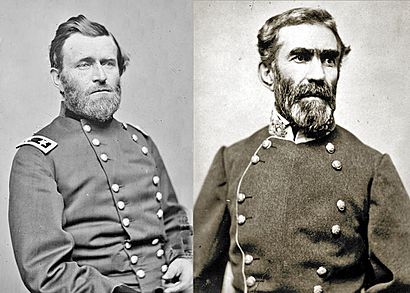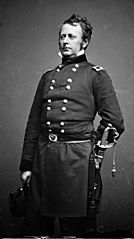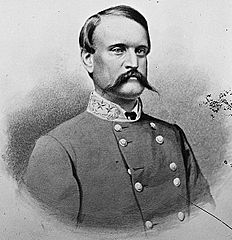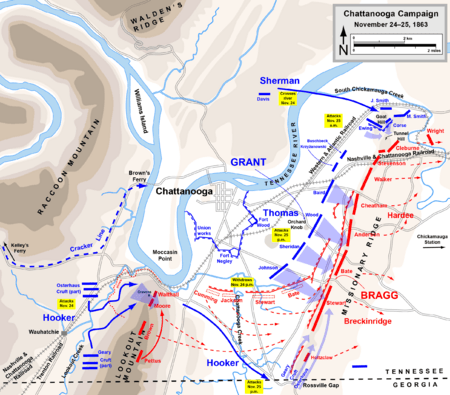Battle of Missionary Ridge facts for kids
Quick facts for kids Battle of Missionary Ridge |
|||||||
|---|---|---|---|---|---|---|---|
| Part of the American Civil War | |||||||
 Battle of Missionary Ridge, Nov. 25th, 1863, by Kurz and Allison |
|||||||
|
|||||||
| Belligerents | |||||||
| Commanders and leaders | |||||||
| Ulysses S. Grant George Henry Thomas |
Braxton Bragg | ||||||
| Units involved | |||||||
|
Military Division of the Mississippi: |
Army of Tennessee | ||||||
| Strength | |||||||
| 56,359 | 44,010 | ||||||
| Casualties and losses | |||||||
| 5,824 total
(753 killed
4,722 wounded 349 captured/missing) |
6,667 total
(361 killed
2,160 wounded 4,146 men captured/missing, 40 cannons also captured) |
||||||
The Battle of Missionary Ridge was a major fight during the American Civil War on November 25, 1863. It was part of the Chattanooga Campaign. After winning the Battle of Lookout Mountain the day before, Union soldiers led by General Ulysses S. Grant attacked Missionary Ridge. They defeated the Confederate Army of Tennessee, led by General Braxton Bragg. This forced the Confederates to retreat into Georgia.
In the morning, Union troops under General William Tecumseh Sherman tried to capture the northern part of Missionary Ridge, called Tunnel Hill. However, strong Confederate resistance stopped them. Later that afternoon, General Grant ordered another Union force, the Army of the Cumberland led by General George Henry Thomas, to attack. Their goal was to take the first line of Confederate trenches at the bottom of the ridge.
The Union soldiers quickly captured these trenches. But then, they faced heavy fire from the Confederate lines higher up the ridge. Instead of stopping, the Union soldiers kept pushing forward. They climbed the steep ridge, even though it was a very difficult and dangerous attack. This surprise charge overwhelmed the Confederate defenses.
Combined with an attack from the south by General Joseph Hooker's troops, the Union Army completely defeated Bragg's army. The Confederates had to retreat to Dalton, Georgia. This victory ended the siege of Union forces in Chattanooga, Tennessee.
Why Did the Battle Happen?
The Situation Before the Fight
After a big loss at the Battle of Chickamauga, about 40,000 Union soldiers retreated to Chattanooga. Confederate General Braxton Bragg's army then surrounded the city. They hoped to starve the Union troops into giving up. Bragg's soldiers set up positions on Missionary Ridge and Lookout Mountain. From these high points, they could see the city, the Tennessee River, and the Union supply routes.
Heavy rains in late September made the mountain roads very muddy. This made it hard for Union supplies to get through. On October 1, Confederate cavalry, led by General Joseph Wheeler, attacked a large Union supply train. They burned hundreds of wagons and killed many mules. This made the Union soldiers' food situation even worse. They were getting very little to eat.
Union Reinforcements Arrive
The Union Army sent more soldiers to help. General Joseph Hooker arrived with 15,000 men from Virginia. General William Tecumseh Sherman came with 20,000 men from Mississippi. On October 17, General Ulysses S. Grant took command of all three Western Union armies. He quickly went to Chattanooga and replaced the previous Union commander with General George Henry Thomas.
General Thomas launched a surprise attack on October 27. His troops crossed the Tennessee River at Brown's Ferry. This opened a new supply route, called the "Cracker Line," into Chattanooga. In response, Bragg ordered General James Longstreet to push the Union forces out of Lookout Valley. This led to the Battle of Wauhatchie, one of the few battles fought at night during the war.
Planning the Attack
Sherman's 20,000 men arrived in mid-November. Grant, Sherman, and Thomas then planned a new attack on Bragg's army. Sherman would attack the northern end of Missionary Ridge. Thomas's divisions would support him from the center. Hooker was supposed to distract Bragg's forces.
Sherman's attack was delayed. So, on November 23, Grant ordered Thomas to make a small attack. This was to see how strong the Confederate lines were. Thomas sent over 14,000 men towards a small hill called Orchard Knob. They quickly captured it from the Confederates. Grant then told Thomas's men to dig in and hold this new position.
Bragg was surprised by Thomas's move. He realized his army's center and right side might be weaker than he thought. He quickly changed his plans. He moved some troops around, including General Patrick Cleburne's division. Bragg also ordered his men to start building stronger defenses on Missionary Ridge. However, they were slow to do this. Some Confederate divisions were ordered to split their forces. Half went to the top of the ridge, and half stayed in trenches at the bottom. The trenches at the top were not placed well, which made them harder to defend.
On November 24, Sherman's troops successfully crossed the Tennessee River. They took some hills at the north end of Missionary Ridge. But they found a valley separating them from the main ridge. Bragg sent Cleburne's division to stop Sherman. Both sides dug in for the night. Meanwhile, Hooker's troops won the Battle of Lookout Mountain. They then prepared to move towards Bragg's left side on Missionary Ridge.
That night, Bragg asked his commanders if they should retreat or fight. Most advised retreating. But General John C. Breckinridge convinced Bragg to stay and fight on Missionary Ridge. So, the troops from Lookout Mountain were moved to help defend against Sherman.
Who Fought in the Battle?
The Union Army
The Union forces were part of the Military Division of the Mississippi, led by General Ulysses S. Grant.
| Key Union Commanders |
|---|
|
The main Union armies involved were:
- The Army of the Tennessee, led by General William T. Sherman.
- The Army of the Cumberland, led by General George H. Thomas.
- A special group of soldiers led by General Joseph Hooker, who had joined the Army of the Cumberland.
The Confederate Army
The Confederate forces were the Army of Tennessee, led by General Braxton Bragg.
| Key Confederate Commanders |
|---|
|
Bragg's army had two main groups of soldiers:
- Hardee's Corps, led by General William J. Hardee.
- Breckinridge's Corps, led by General John C. Breckinridge.
Earlier in November, Bragg had sent some of his soldiers away to fight elsewhere. This made his army weaker for the Battle of Missionary Ridge.
The Battle Begins
On November 25, General Grant's main plan was for Sherman to attack Bragg's right side at Tunnel Hill. Thomas's army was to support this attack. Grant didn't expect much from Hooker, other than to keep Bragg busy. However, Thomas wanted more support and asked Hooker to move across the valley and attack Bragg's left side.
Sherman's Attack at Tunnel Hill
Sherman had about 16,600 men for his attack. The Confederates defending Tunnel Hill had about 9,000 men, with more on the way. At dawn, Sherman was supposed to attack, but he delayed until about 9:00 AM. He sent only two brigades to attack.
Sherman's troops tried to attack Tunnel Hill from different directions. They captured some unfinished defenses. But when they charged the main Confederate position, they were pushed back. After several tries, Sherman stopped attacking from that spot. The fighting then moved to the west side of the ridge.
The Confederates, led by General Cleburne, fought very hard. They were almost overwhelmed, but then they launched a strong counterattack. Around 4:00 PM, the Confederates charged down the hill. They defeated Sherman's tired and low-on-ammunition men. Many Union soldiers were captured.
Sherman's attack failed. He lost almost 2,000 soldiers. He used only a small part of his army in a direct attack on a very strong position. Some historians say this was Sherman's "worst experience as a commander." Others praise General Cleburne for his smart defense.
Thomas's Charge Up the Ridge
Around 2:30 PM, General Grant saw that Sherman was having a tough time. He decided to send General Thomas J. Wood and General Philip Sheridan's divisions to attack the Confederate trenches at the base of Missionary Ridge. He hoped this would make Bragg worry and help Sherman. Grant told Thomas his idea, but Thomas was hesitant.
Grant got annoyed and ordered Thomas to tell his troops to advance and take the first line of trenches. At 3:00 PM, Thomas gave the order. About 23,000 Union soldiers in four divisions prepared to attack. They faced about 20,000 Confederates defending the center of the ridge.
Around 3:40 PM, the signal guns fired. The Union soldiers charged forward. The 9,000 Confederates in the trenches at the base of the ridge were confused by conflicting orders. Some were told to fire and retreat, others to hold. The Union soldiers, shouting "Chickamauga!", quickly overwhelmed them. Many Confederates were captured, and the rest ran up the steep ridge.
The 100 Confederate cannons at the top of the ridge didn't hit many Union soldiers at first. But once the Union troops stopped in the captured trenches, the cannons started firing accurately. Confederate riflemen also fired down, causing many casualties. After a few minutes, some Union commanders decided to move their men forward again to escape the heavy fire.
Without direct orders, some Union soldiers started climbing the ridge. Their commanders then ordered them to keep going. When General Wood reached the trenches, his second line of men begged him to let them climb too. Wood sent them forward.
Grant was shocked to see his troops climbing the ridge. He asked Thomas and Granger who gave the order. Neither claimed responsibility. Granger famously replied, "When those fellows get started, all hell can't stop them." Grant then allowed them to continue.
The Union advance was disorganized but very effective. On the far left, two brigades captured the trenches. Other brigades, like General Turchin's, pushed up the ridge. On the right, General Wagner's brigade started climbing but was ordered to pull back. They suffered heavy losses. But seeing other Union units still climbing, Wagner sent his men back up the ridge.
The Confederate line broke around 5:00 PM. Union soldiers found a weak spot and rushed over the Confederate defenses. The Confederate generals had no extra troops to send as backup. When Union troops appeared on their sides, they had to pull soldiers from their main defense line. This made their main line even weaker as more Union brigades swarmed up the ridge.
Once on top, Union brigades spread out, attacking the Confederate lines from the front and sides. Many Confederate soldiers panicked and ran. They often left their cannons behind. Entire Confederate divisions were defeated. Only General Cleburne's command managed to retreat in an organized way. By 6:00 PM, the center of Bragg's line had completely collapsed. The Confederates fled in panic, abandoning Missionary Ridge.
Hooker's Advance at Rossville Gap
After leaving Lookout Mountain around 10:00 AM, General Joseph Hooker's troops faced a problem. The bridges over Chattanooga Creek had been burned by the Confederates. It took Hooker's men about three hours to rebuild a bridge and cross the creek. This delayed their advance until 3:30 PM.
General Breckinridge, who was in charge of that part of the Confederate line, was worried about his left side. He ordered some regiments to hold Rossville Gap, a break in the ridge. But it was too late. Hooker's troops had already marched through the gap. Breckinridge's own son, an aide, was captured by Union soldiers.
Hooker quickly turned his troops north and attacked in three directions. His men pushed the outnumbered Confederates north along Missionary Ridge. Eventually, Hooker's forces met up with Union troops from Thomas's attack. Surrounded on all sides, about 700 Confederate soldiers surrendered.
What Happened Next?
That night, General Bragg ordered his army to retreat. They moved towards Chickamauga Station and then continued retreating to Dalton, Georgia. The Union pursuit was stopped by Cleburne's strong defense at the Battle of Ringgold Gap.
The battles around Chattanooga (Orchard Knob, Lookout Mountain, and Missionary Ridge) resulted in about 5,824 Union casualties (soldiers killed, wounded, or missing). The Confederates had about 6,667 casualties, mostly prisoners. The Union Army also captured 40 cannons.
The Confederate army was badly defeated. The Union now had full control of Tennessee, including Chattanooga, which was a very important city. Chattanooga became a key supply base for General Sherman's Atlanta Campaign in 1864. This was General Grant's last major victory in the West before he took command of all Union armies.










